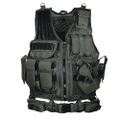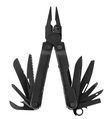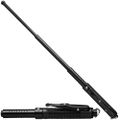No edit summary |
|||
| Line 20: | Line 20: | ||
* Standard Issue Survival Knife | * Standard Issue Survival Knife | ||
* [[Solas Tempus Communicator]] | * [[Solas Tempus Communicator]] | ||
* [[Vertex Scanner]] | * [[Vertex Scanner]] or [[Vertex Combat Scanner]] Depending on Deployment Needs | ||
* Multi-Tool | * Multi-Tool | ||
* Tactical Flashlight | * Tactical Flashlight | ||
Revision as of 22:57, 26 August 2021
These are the standard equipment loadouts for personnel on missions or while simply on duty. Commanding officers may give special exceptions for personal weapon / equipment choices, so long as they are comparable to the standard issue. While a standard duty officer does not wear a utility vest (as shown to the right), they do wear a version of the utility belt (also shown to the right).
Examples of Standard Equipment
-
Utility Vest
-
Utility Belt
-
Tactical Flashlight
-
Multi-Tool
-
Survival Knife
-
Collapsible Baton
-
Wrist Restraints
-
S&W 500 Pistol
Standard for All Personnel
Certain specific missions may require deviations from this equipment set, such as a stealth mission or other covert operation. Some instances may also require that an energy weapon cannot be used, and thus the Mark II-PX Railgun can be used instead. The S&W 500 pistol is an often used alternative with a variable ammunition, though this is not a suggested weapon as it has a limited carrying capacity before it requires to be reloaded. This is, of course, not an exhaustive list.
- Sidearm (Standard is a Type II Assault Phaser Pistol)
- Backup Weapon (Standard is a Type I Phaser)
- Standard Issue Survival Knife
- Solas Tempus Communicator
- Vertex Scanner or Vertex Combat Scanner Depending on Deployment Needs
- Multi-Tool
- Tactical Flashlight
- Collapsible Baton
- Extra Power Packs / Ammunition
Effectiveness of Energy vs Projectile
It should be noted that many the utility of the standard energy weapon based Phaser (or other cohesive particle beam weapon) is unparalleled. While personnel are welcome to choose their own sidearms, they are required to maintain at last one particle energy weapon - be it their backup weapon (suggested Type I Phaser) or their primary sidearm (suggested Type II Phaser). This is because the phaser is useful not only as a weapon but as a tool, the nadion particle beam is able to heat objects to provide heat in cold climates, melt obstructions, a wide-beam stun setting can incapacitate small to medium sized crowds without causing physical harm, and is effective against shielded objects. Conventional propellant based weapons such as the explosive propelled projectils common in firearms are not effective in the same way.
A particle beam can also be used as a cutting torch, power cells can be extracted to power most emergency transmitters, and to power door locking / unlocking mechanisms during missions. This is why it is standard equipment. Under General Order 3A Solas Tempus personnel are free to choose their own sidearms and other equipment with comparable capabilities, the popularity of propellant based firearms or the more advanced railgun cousins has been on the rise since. General Order 79 specifies that all personnel must have a particle beam weapon on hand, even if their primary choice is that of a projectile weapon, unless deemed unsafe or impossible by specific mission parameters. Extended preference toward projectile based weapons should also be investigated as a potential opportunity for additional training.
Causes for General Order 79
This is due to an increasing number of incidents where security or other officers chose to carry the less-useful projectile firearms and were unequipped to handle situations as they unfolded. In one particular case, the entire security team of 6 was killed when an unruly mob on Gamma Kappa VII could not be incapacitated in time and beat the security team to death. Another less tragic incident 5 members of an away team were lost due to hypothermia on an arctic world when they were trapped in an ice-cave by a cave in. No member at the time had a particle weapon on hand to heat stone within the cave or melt the ice walls sufficiently to escape. Both would have been possible with a particle energy weapon.
Lethal vs. Nonlethal
Under General Order 7D all personnel are required to use non-lethal force whenever it does not risk endangering others. Thus phasers should be set to stun whenever possible, hand to hand combat should focus on disabling an attacker, and when firearms are to be used the preference should be on non-lethal shots to disable an attacker. This allows for a higher probability for peaceful resolutions to many situations and attackers to be secured and questioned by security officials or military intelligence.
On Duty Loadouts
Designed for deployment within or near a Solas Tempus facility.
Security / Guard Duty
- Ocular Heads Up Display
- Class 1D Body Armor
- Wrist Restraints
Heavy Guard Duty
- Type III Assault Phaser Rifle
- Class 1M Combat Armor
- Wrist Restraints
Mission Loadouts
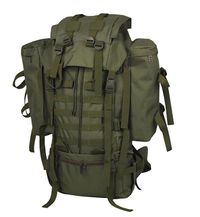
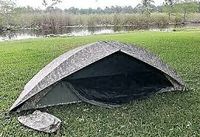
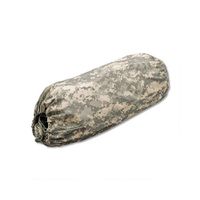

Missions away from a Solas Tempus facility or vessel require more equipment. The standard equipment listed above is also present but the addition of a high capacity backpack. The standard away-mission loadout is the Standard Mission which can be entirely deployed within the confined of the backpack including all standard equipment. In addition to the gear listed below all away missions also include TKL Energy Bars (6) as well as 3 days of standard rations (9 Solas Tempus IMPs). A standard loadout of water consists of 2 1-liter water bottles, this assumes one can easily find potable water and a canvas hat. For environments with limited or difficult to find potable water, 6 1-liter water bottles is the standard for 3 days of provisions. Room in the packs is also reserved for mission-variable requirements.
The backpack also has a variety of attachment methods designed to be used with the various kinds of armor. Full-body armors such as the Class 1M, 1K, etc are also fitted to be able to attach the standard vest, backpack, and belt equipment to.
Each person should deploy with a standard 1-Person Combat Shelter available. Each of these can be used singly or can also be reconfigured to create a larger structure for a group of people.
Standard Mission
- Ocular Heads Up Display
- Class 1D Body Armor
- Standard Issue Plasma Grenades (Total of 2)
- Thermolyte Explosive Clay (Total of 2, 1 Pound Bricks)
- 4-Pack of Short Range Tactical Surveilling Drones
At a commanding officers discretion the standard equipment may not include many of the provisions, tent, and high capacity backpack. rather use the utility vest to allow for better mobility or for short-term excursions and quicker prep time. Standard procedure outlines that in the event a team is deployed without the additional equipment, a partial tactical pack be made ready to supplement the teams equipment if necessary. In this case the equipment is considered "Light" and only contains 2 liters of drinkable water and 3 TLK bars, roughly enough for one day.
Combat Mission
- Type III Assault Phaser Rifle
- Class 1M Combat Armor
- Standard Issue Plasma Grenades (Total of 4)
- Thermolyte Explosive Clay (Total of 4, 1 Pound Bricks)
- 4-Pack of Short Range Tactical Surveilling Drones (2, Total of 8 Drones)
Assault Mission
Heavy assault missions may require more weapons power, thus the standard pistol can be swapped out for a heavier duty weapon.
- DRX-23 Compressed Positron Beam Rifle or Mark IX Railgun
- Type II Assault Phaser Pistol, DPX-09 Compressed Positron Beam Pistol, or Mark II-PX Railgun
- Class 1K Advanced Cybernetic Exoskeleton
- Standard Issue Plasma Grenades (Total of 4)
- High Explosive Ultritium Grenades (Total of 2)
- Thermolyte Explosive Clay (Total of 6, 1 Pound Bricks)
- 4-Pack of Short Range Tactical Surveilling Drones (4, Total of 16 Drones)
Tactical Pack Payload
A standard tactical pack consists of necessities for a squad in a survival or other dangerous situation. The pack is designed for a full squad to survive in the field for 7 days. The pack is modular each module contains supplies for 1 person, standard payload is supplies for 10. This allows the pack to be automatically adjusted for unit size prior to deployment.
Drop methods vary, most used is a simple crate-beam-in. Packs can be deployed via automation beamed directly into position in a protective (and locked if required) crate. Each per-person loadout will be packed in its own backpack alongside other supplies to be distributed at the time of deployment. Other drop-methods used are sub-orbital or high-altitude drops, though these methods cannot be as easily targeted, thus are equipped with a locator beacon.
Per-Person Payload
- Standard Equipment
- Type II Assault Phaser Pistol
- Type I Phaser
- Survival Knife
- Solas Tempus Communicator
- Tricorder
- Multi-Tool
- Tactical Flashlight
- Collapsible Baton
- Standard Mission Gear
- Ocular Heads Up Display
- Class 1D Body Armor
- Standard Issue Plasma Grenades
- Termolyte Explosive Clay
- 4-Pack of Short Range Tactical Surveilling Drones
- Rations for 7 Days
- Solas Tempus IMP (21)
- TKL Bars (14)
- All-Weather Sleeping Bag
- 1-Person Combat Shelter
- 6 1-Liter Water Bottles
Per-Pack Payload
- Type III Assault Phaser Rifles (2)
- Medical Kits (2)
- Subspace Transceiver /w Mobile Array
- Designed to deployed in a fixed location to provide a stable uplink to a subspace network. Can also be used as a mobile power source and for a light way communications relay.
- SVR Generator
- Low-load Spatial Variance Reactor using a quartet of SVR's to generate stable and continuous low-load power. Generator also has a high-capacity battery that it charges continuously for high-load activities.
- Molecular Resequencer
- Low-energy replicator which uses existing matter and resequences the matter into simple constructs. This includes simple molecular patterns such as water, diatomic elements, simple metal alloys, or similar materials. Unfortunately this cannot produce complex objects, limited to providing base materials from existing matter. There is also a 10-20% mass-energy conversion during resequencing which is energy lost or consumed in the process.
Rescue Pack
In some situations an extraction team may be required to prepare (or a vessel in orbit may be required to prepare and deploy via automation) a rescue pack. This pack is designed for the express purpose of setting up an area for assets to be extracted from an extremely hazardous area in the event transporters are not available. This pack is specifically designed to deployed from either high altitude or even low-orbit using a torpedo casing. The rescue pack provides 5 transport enhancers at a high-output fusion reactor as well as a locator beacon and instructions for use. The beacon, reactor, and transport enhancers can be used to provide a stable window for a transporter to function in most situations where transporters do not otherwise function.
